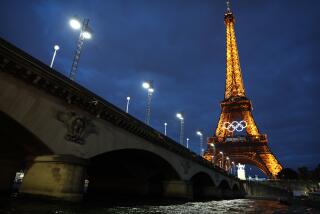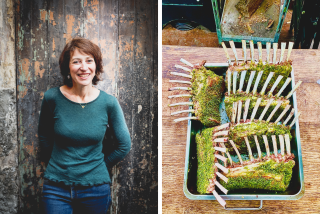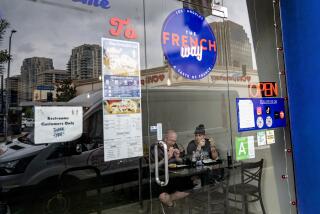Dining Through Truffle Country : In Franceâs Perigord region, winter is the season to sample fois gras and an increasingly rare fungus.
PERIGUEUX, France â Last winter, I had to drive from Paris to the Atlantic side of Spain. As it was the height of the foie gras and truffle season in France, I decided to go by way of the historic region of the Perigord--which happens to be the very heart of French foie gras and truffle country. (Foie gras is the fattened, creamy-rich liver of ducks or geese force-fed with grain; truffles, in this case the black variety, are a dense and intensely flavorful fungus--a bit like mushrooms condensed to edible diamonds. Both are expensive gastronomic luxuries, and both are delicious.)
The Perigord begins just below Limoges, roughly 250 miles south and a bit west of Paris. It is possible to reach Perigueux--the regionâs capital--by car from Paris in seven or eight hours, on a combination of autoroute, national highway and regional road, via Orleans, Tours, Poitiers, Angouleme and Brantome. I got a late start, though, and stopped for the night about halfway down, on the outskirts of Poitiers. Here, in a pretty little corner of an otherwise not very interesting village called Saint-Benoit, I found a pleasant and reasonably-priced hotel/restaurant called Chalet de Venise. It turned out to be a real discovery.
The Chaletâs name is a flight of fancy; itâs housed in a rather grim-looking 1930s style structure, rather than a chalet, and evokes Venise (Venice) only by the presence of a small, barely navigable canal which passes behind the place. But the rooms are comfortable, the dining room is welcoming and the kitchen is absolutely first rate, serving food that is wonderfully fresh and imaginative without being silly. I dined on an appetizer of filet mignon of lamb with asparagus in warm vinaigrette, a main dish of pike-perch in meat juices with creamy chive-spiked pureed potatoes and a selection of superb local goat cheeses--all for around $40, including tip and a bottle of decent Loire wine.
I slept peacefully, left at a reasonable hour and by noon the next day was in Perigueux.
The greatest attraction in Perigueux today is the ancient core of the town itself, now a protected pedestrian quarter or Secteur Sauvegarde. It is a great pleasure to wander through the pretty little stone streets here, between the cathedral and the museum, past well kept-up old buildings (some of which house very smart little boutiques and tempting food shops), into luminous little squares which you come upon unexpectedly (almost as in Venice). The Renaissance houses on the Rue Limogeanne, Rue de la Misericorde and Rue Eguillerie are particularly handsome--and in very good repair, clean and bright.
Strolling through the Secteur Sauvegarde myself, I came suddenly into the beautiful little Place St-Louis, a raised rectangular square framed in sober but graceful white stone buildings--and found foie gras and its relatives in full array. This was the townâs twice-weekly Marche au Gras or Fat Market. Inside a large off-white canvas tent, at long tables, a score or so of local duck and goose farmers--old and young, male and female--displayed their products for sale. There was foie gras of several grades; there were whole ducks and geese, duck and goose fat both in slabs and rendered (in glass jars), rillettes (shredded meat preserved in fat) made of both creatures, gizzards and other organs, even stripped duck carcasses (great for soup)--at about $2 apiece. Here and there, a farmer also sold his or her own honey, walnut oil or eggs (both chicken and duck)--but the market was above all a tribute to the delicious variety of the regionâs famous fowl.
In case youâre blanching at the very thought of all this raw cholesterol, I might point out that on Nov. 17, 1991, a front-page story in the New York Times reported on a 10-year French epidemiological study of the dietary effects of duck and goose fat, in the form of foie gras and otherwise. The surprising result of the study, according to Dr. Serge Renaud, director of research at the French National Institute of Health and Medical Research in Lyon, was the discovery that these dangerous-sounding substances might actually be beneficial to the human circulatory system--might actually help clear arteries rather than clogging them. âGoose and duck fat,â Renaud explained, âis closer in chemical composition to olive oil than it is to butter or lard.â (That date was a great one for the gourmet set: The same evening, â60 Minutesâ broadcast its now-famous report on the so-called âFrench paradox,â praising the purportedly salutary values of red wine.)
In any case, though I couldnât buy any foie gras or other fatty products at the Marche au Gras (they arenât very practical to travel with), I did find the display fascinating and appetizing--and I was ready for lunch.
The choice of restaurants in Perigueux is surprisingly cosmopolitan. There are Chinese places and pizzerias, of course, as there are in virtually every French town of any size--but there is also an Indian/Pakistani restaurant, a Lebanese one and at least one Japanese establishment
The best place to eat in town, though, is a delightful, strictly French restaurant called LâOison, just across the street from the St-Front cathedral. The dining room is pretty and light, in a cheery cream and yellow color scheme. Co-proprietor Brigitte Chiorozas offers a smiling welcome and takes very good care of diners, while her husband, chef Regis, cooks excellent food. The local gastronomic treasures, foie gras and truffles, appear in imaginative, refined forms--for instance, a salad of potatoes and truffles or a kind of opulent terrine of truffles, potatoes and foie gras. Such delicacies are expensive, of course--but there is also a superb fixed-price menu, for about $35 per person, that might include smoked cod puree with tomato sauce and garlic toast, roasted guinea fowl with roasted new potatoes and carrots and praline ice cream with strawberry sauce. Wine is extra, but there is a very good selection of inexpensive bottles from the region--for instance, the very good Chateau de la Jaubertie red or white, made in nearby Bergerac by an Englishman named Henry Ryman, priced here at about $15 each.
About 15 miles northeast of Perigueux, on the N-21 highway, is the village of Sorges, the truffle capital of the Perigord. And where would a visitor to a place with this distinction stay but at the Auberge de la Truffe--the Inn of the Truffle? This simple but comfortable roadside hotel--whose proprietress, Jacqueline Leymarie, signs her correspondence âPerigordialment votre,â âPerigordially yoursâ--offers quiet, basically furnished rooms (but with color TVs and large bathrooms), and, in warm weather, a small pool and a very pleasant terrace for dining or lounging. What it is mostly known for, though, is copious, homey food.
Above all, this is a dining room (warm, if unfortunately fluorescent-lit) devoted to the fixed price menu. There are eight or 10 of them in all, offering everything from a childrensâ meal (salad, chopped steak with fries and ice cream, at about $8) or a hearty peasant-style repast (vegetable soup, poached chicken and dessert for around $14) to a serious eaterâs banquet of foie gras terrine (absolutely straightforward but very good), cassoulet, salad, cheese and dessert, all for about $45. One side dish not to miss: pommes sardalaise or potatoes in the style of Sarlat. Often, this dish is interpreted as a sort of cottage-fried-potato cake with the potato slices interleaved with truffles. Here itâs more down-to-earth, but no less delicious--potatoes pureed with wild mushrooms and bits of truffle, and moistened with goose fat. (Remember: It might be good for your heart.)
Across the street from the Auberge de la Truffe is the Ecomusee de la Truffe, a small museum in an old stone house, devoted to the lore of truffles. The labels and explanatory texts are in French only, but much of the material is visual--photographs, charts--and relatively easy to figure out. Among the truffle facts I learned here were: Truffles and the trees beneath which they grow (usually oaks and hazelnuts) have a symbiotic relationship, providing nutrients to each other in the soil. Though pigs are excellent truffle hunters, dogs are generally preferred--for the simple reason that pigs like to eat truffles and dogs do not. The natural truffle is disappearing: In 1904, about 100 tons of truffles were harvested throughout France; in 1983, the last year for which the museum has records, only 12 tons were harvested. On the other hand, it has recently become possible for the first time to cultivate truffles instead of merely hunting them when they occur.
From mid-December to the end of February, there are truffle markets one day a week in many towns in the area--among them, Excideuil, Brantome, Vergt and Perigueux. As with the Fat Markets, these are of limited practical use to the traveler--you canât bring raw, unpackaged truffles back to the United States--but, again, like their gras- fueleds counterparts, theyâre great stimulants to the appetite.
The Ecomusee de la Truffe also maintains a Sentier des Truffieres or Truffle-Huntersâ Path in the woods near Sorges, just outside the village of Puycousin. This is a self-guided, mile-and-a-half walk through prime truffle country. Along the way are positioned some 14 explanatory placards (again only in French), describing virtually every aspect of the truffle hunting and cultivating processes. Before setting off for Spain after my night in Sorges, I had every intention of following the truffle path--but then it started raining hard and my resolve weakened quickly. Anyway, I had forgotten to bring my dog or my pig.
GUIDEBOOK
Perigord for the Epicure
Getting there: The fastest way to reach the Perigord is by plane from Paris (about one hour) to Bordeaux or Limoges and then by rental car. ) To drive from Paris, take the A-71 autoroute south, past Orleans and Tours, to Poitiers. At Poitiers, continue south on the N-10 (also marked E-3) national road to Angouleme, then take the D-939 road through Brantome to Perigueux.
Where to stay: En route from Paris, Le Chalet de Venise, 6 Rue Square, Saint-Benoit (Poitiers); from the United States, telephone 011-33-49-88- 45-07; closed Mondays and in January and the first week of September; about $45-$55 per night. In the Perigord Blanc, Auberge de la Truffe, N-21, Sorges; 011-33-53-05-02-05, fax 011-33-53-05- 39-27; about $45 for one person, $50 for two per night.
Where to eat: En route, Le Chalet de Venise (see above); lunch or dinner for two with modest wine, $110 a la carte; fixed-price menus at about $20, $28 and $38 per person without wine. In the Perigord Blanc, LâOison, 31 Rue St-Front, Perigueux; 011- 33-53-09-84-02; lunch or dinner for two with modest wine, $135; fixed-price menus at about $35, $55 and $85 per person without wine. Auberge de la Truffe (see above); lunch or dinner for two with modest wine, $110 a la carte; numerous fixed-price menus, $15-$45 per person without wine.
What to do: Ecomusee de la Truffe, N-21, Sorges; 011-33-53-05-90-11; open Tuesday-Sunday, 10 a.m. to noon and 2 p.m. to 5 p.m.; about $3 admission. Sentier des Truffieres: Drive south from Sorges on the N-21 toward Savignac-les-Eglises. Just past the village of Puycousin, look for green arrows pointing to the Sentier des Truffieres parking area. Follow arrows and signs along the path. The walk takes about 1 1/2 hours at a leisurely pace. There is no admission charge.
Truffle markets: Mornings in numerous towns in the Perigord, from approximately 9 a.m. to noon, from mid-December through the end of February.
Marches au Gras: Approximately same hours as truffle markets, but held from mid-November through end of March. Among many towns in the Perigord where such markets may be found: Perigueux (Wednesday and Saturday), Bergerac (Wednesday and Saturday), Thiviers (Saturday), Vergt (Friday), Sarlat (Saturday) and Excideuil (Thursday).
More to Read
Sign up for The Wild
Weâll help you find the best places to hike, bike and run, as well as the perfect silent spots for meditation and yoga.
You may occasionally receive promotional content from the Los Angeles Times.






